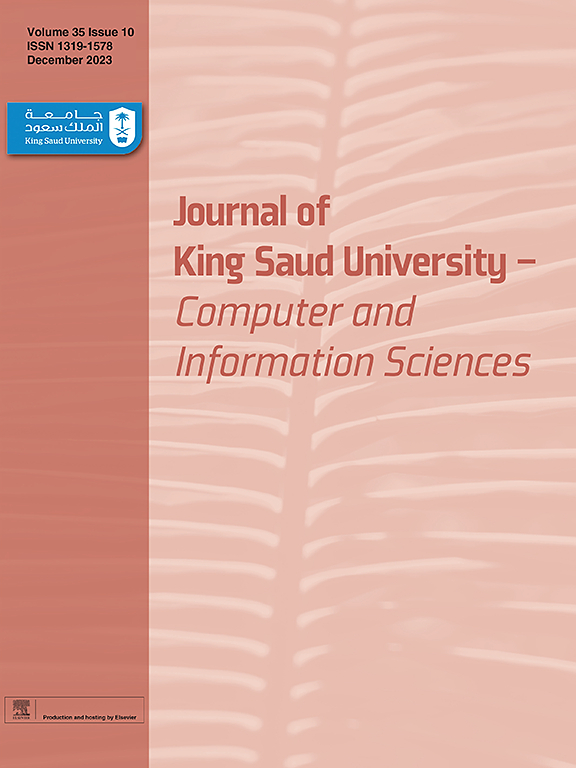LMGA:用于安全用药推荐的轻量级多图增强网络
IF 5.2
2区 计算机科学
Q1 COMPUTER SCIENCE, INFORMATION SYSTEMS
Journal of King Saud University-Computer and Information Sciences
Pub Date : 2024-11-17
DOI:10.1016/j.jksuci.2024.102245
引用次数: 0
摘要
大规模电子健康记录(EHR)的快速积累见证了智能医疗的繁荣,例如药物推荐(MR)。然而,大多数研究要么未能充分捕捉各种医疗记录之间的结构相关性和时间依赖性,要么忽视了 MR 模型的计算效率。为了填补这一空白,我们提出了一种轻量级用药推荐方法,该方法将双向门递归单元(BiGRUs)与基于多重图增强网络(LMGA)的轻图卷积网络(LGCNs)整合在一起。具体来说,BiGRU 用于编码纵向就诊历史,并从整体角度生成患者表征。此外,还构建了一个记忆网络来提取患者历史 EHR 中的局部个性化特征,并部署 LGCNs 来学习药物共现和拮抗关系,从而在减少计算资源需求的情况下获得完整的药物表征。此外,还利用药物分子图来捕捉结构信息,并控制预测药物组合中潜在的 DDI。结合患者和药物的表征,可以提供轻量级的安全药物推荐,从而在降低计算资源消耗的同时提高预测性能。最后,我们在两个公开数据集上进行了一系列实验来评估所提出的 LMGA,实验结果表明,与最先进的基线模型相比,LMGA 在 MR 任务中的性能更优越。本文章由计算机程序翻译,如有差异,请以英文原文为准。
LMGA: Lightweight multi-graph augmentation networks for safe medication recommendation
The rapid accumulation of large-scale electronic health records (EHRs) has witnessed the prosperity of intelligent medicine, such as medication recommendation (MR). However, most studies either fail to fully capture the structural correlation and temporal dependence among various medical records, or disregard the computational efficiency of the MR models. To fill this gap, we put forward a Lightweight Medication recommendation method which integrates bidirectional gate recurrent units (BiGRUs) with light graph convolutional networks (LGCNs) based on the multiple Graph Augmentation networks (LMGA). Specifically, BiGRUs are deployed to encode longitudinal visit histories and generate patient representations from a holistic perspective. Additionally, a memory network is constructed to extract local personalized features in the patients’ historical EHRs, and LGCNs are deployed to learn both drug co-occurrence and antagonistic relationships for integral drug representations with reduced computational resource requirements. Moreover, a drug molecular graph is leveraged to capture structural information and control potential DDIs in predicted medication combinations. Incorporating the representations of patients and medications, a lightweight and safe medication recommendation is available to promote prediction performance with reduced computational resource consumption. Finally, we conduct a series of experiments to evaluate the proposed LMGA on two publicly available datasets, and the experimental results demonstrate the superior performance of LMGA in MR tasks compared with the state-of-the-art baseline models.
求助全文
通过发布文献求助,成功后即可免费获取论文全文。
去求助
来源期刊

Journal of King Saud University-Computer and Information Sciences
COMPUTER SCIENCE, INFORMATION SYSTEMS-
CiteScore
10.50
自引率
8.70%
发文量
656
审稿时长
29 days
期刊介绍:
In 2022 the Journal of King Saud University - Computer and Information Sciences will become an author paid open access journal. Authors who submit their manuscript after October 31st 2021 will be asked to pay an Article Processing Charge (APC) after acceptance of their paper to make their work immediately, permanently, and freely accessible to all. The Journal of King Saud University Computer and Information Sciences is a refereed, international journal that covers all aspects of both foundations of computer and its practical applications.
 求助内容:
求助内容: 应助结果提醒方式:
应助结果提醒方式:


